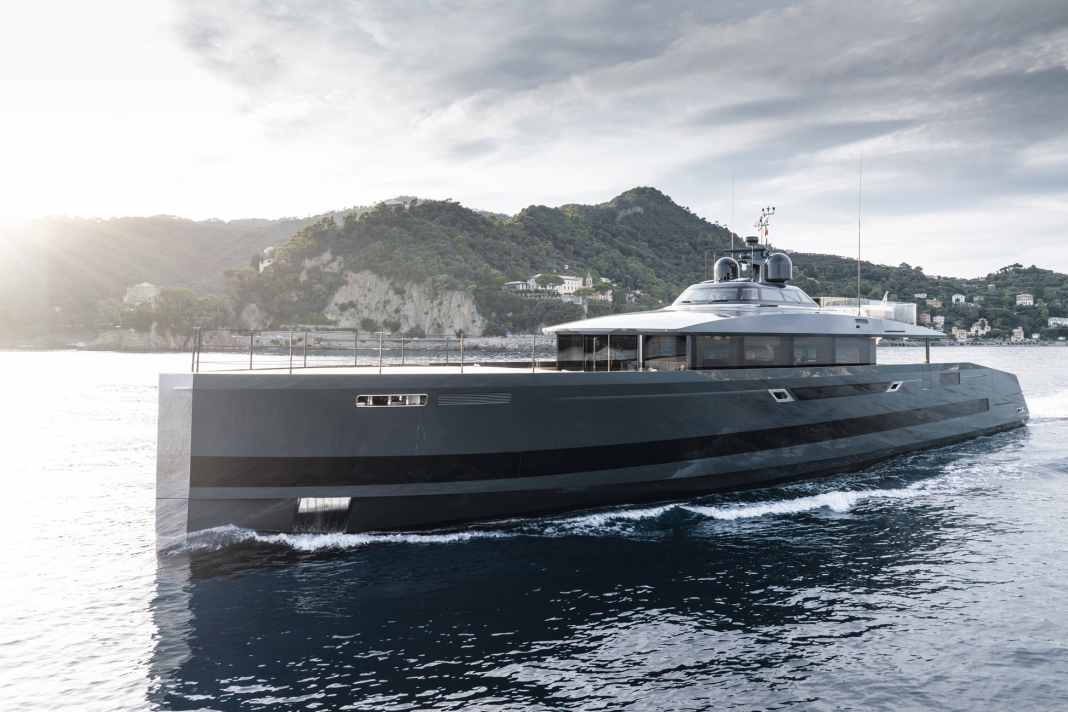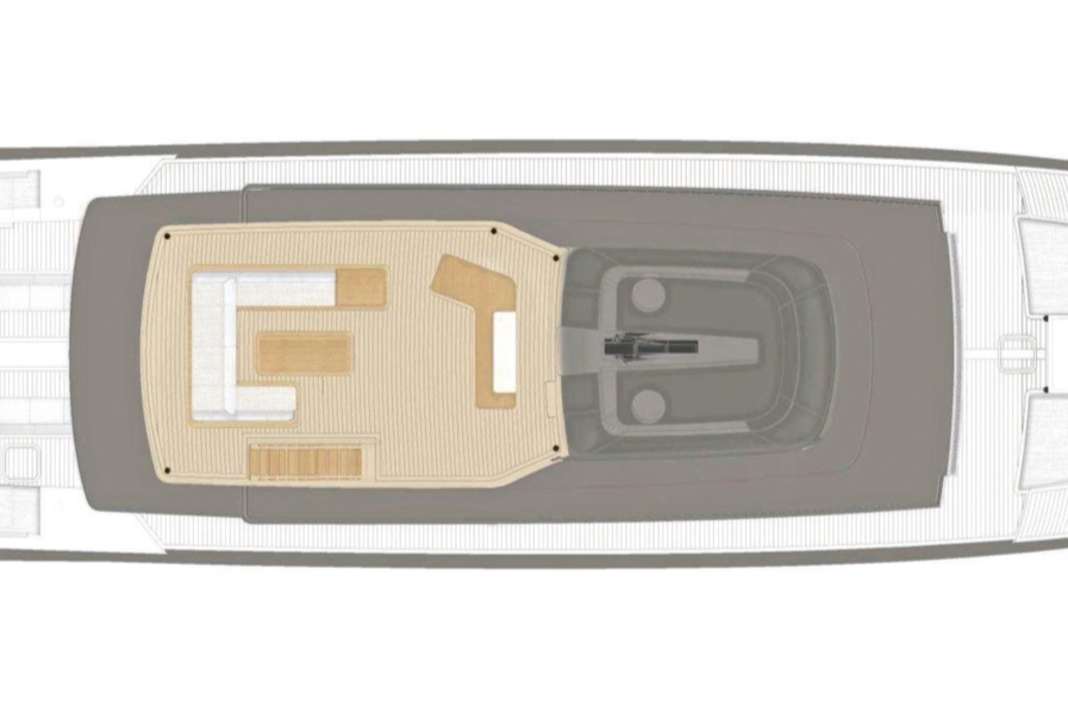





Shipyards avoid coincidences when building their yachts like salt humps avoid fresh water. Away from this, things look different. In connection with trade fair appearances, there is often talk of the one customer who makes the costly presence a commercial success. This does not only apply to shipyards. Alia Yachts has already won over the owner in question. The Turkish shipyard had developed a rough concept, met the customer during the Monaco Yacht Show and suggested a design studio that could work out his many ideas. Now it came to the final hour of the show, when Alia's management was looking for Paul Costerus from Sinot Yacht Architecture & Design. The senior yacht designer and project manager was found in the hustle and bustle, and he immediately struck a creative chord.
The importance of stealth wealth on the water
It was about stealth wealth on the water. This refers to a style of clothing that expresses the fact that you can't see their wealth. However, insiders know how to correctly interpret this textile restraint in monetary terms. Just under six years later, "SAN" proves that omission is a fine art with its - naturally discreet - appearance in the Principality. They agreed on 45 metres and aluminium as the building material. Everything else was much more difficult to grasp.
The keel laying in Antalya was preceded by two years of lively dialogue between the studio, based south-east of Amsterdam, and its client. In the meantime, the client had taken a liking to the "Pi" interior designed by Sinot and had clear ideas: He wanted to be able to see the bow when he came on board via the terraced stern. The motto for in between: Maximum reduction.
The main deck is occupied solely by the saloon, which is less than a third of the length of the hull. It is a room without walls and therefore without a day toilet; all the pipes run through the corner pillars to the steering position. The layout therefore accounted for the lion's share of the development work. "The biggest challenge with a yacht of this volume is that every square centimetre has to be optimised," says Paul Costerus in the "SAN" saloon. "Nevertheless, we had to make sure that you can still move around comfortably on the yacht." Ergonomics dictated a general ceiling height of 2.30 metres, while at the same time the owner of "SAN" demanded a very flat yacht.
High bulwark reduces the force of the glass superstructure
In order to create the impression of a lower superstructure and to prevent the massive window fronts from looking like a clumsy conservatory placed on the deck, the Sinot designers raised the bulwarks by one metre. This made a railing superfluous; from the outside, a bevelled edge reduces the massiveness.
Trapezoidal windows provide a sea view from the lowered seating area in the centre of the saloon. Veraver's windows extend down to the floor, which supports the lower edge of the frame. Costerus: "The owner always wanted to have the feeling that you are on the water." The recess on the main deck was necessitated by the wheelhouse above it, which was also recessed and required one of the many calculations made by Lateral's designers.
In the interior, too, the aim was to make a lot out of a little
The exterior surfaces of the cockpit have been designed to be far more flexible. The main seating area can be set up with a low table for drinks and snacks. If the table is raised and extended, the sofas moved together and the backrests straightened, the result is a dining area with protection from the sun deck above. Every single seat outside can be transformed and used several times and extended aft when the bulwark is folded down.
In the interior, the Dutch creatives were again faced with the challenge of creating a big impression with little: "He wanted a warm yacht, but a very limited number of materials. There are three types of wood in a total of five finishes, two fabrics, one leather and two metal surfaces. That was it," reports Costerus. "That was our biggest challenge: to create warmth and cosiness without any special materials." The few exquisitely crafted furnishings come from the shipyard's own joinery, which was responsible for the entire interior and furniture construction apart from the dining table and chairs. There is storage space up here, but it is not immediately obvious. If you want to sit in the glass house, you have to make compromises. The seating area is surrounded by shelves and sideboards, with two shallow cupboards aft and a bar forward, next to which a spiral staircase leads down to the lower deck.
The Antalya shipyard is characterised by flexibility: "With much larger yachts, you have to stay within a box. Here we were always able to say to the shipyard: Hey, there's a gap there, can we utilise this area? The answer was always yes," says Paul Costerus with regard to the meticulous lower deck planning.
Meticulous planning of the lower deck volumes
As with sailing yachts, of which Alia has already built two, the interior follows the shape of the ship's side. The 8.89 metre wide aluminium hull accommodates the owner's suite at the front, four guest cabins, galley, crew areas for seven people and the engine room at the very back. This was only possible because the decision was made in favour of IPS units from Volvo Penta. By dispensing with shafts, the gensets were moved into a flat space, where they sit directly in front of the pods and release up to 735 kilowatts each. Under full load, "SAN" runs at 23 knots, while a gyroscopic stabiliser from Veem with 260 kilonewton metres of torque ensures rocking-free slow speed. The realisation took three and a half years at Alia Yachts in Antalya. The Turkish shipyard realised a similar concept in 2019 with "Atlantico" (27 m), but also specialises in large-scale projects such as "Al Waab" or support formats such as the "Phi Phantom" and the recently delivered "Kaiyo". Alia CEO Gökhan Çelik illustrates the high level of vertical integration on the "SAN" foredeck with the carbon hatch, which was laminated in the company's own halls. A six-metre RIB with crane rests underneath, while a Wallytender 48 occasionally floats outboard in the anthracite of the mother ship.
Bluetooth speakers instead of a complex audio system
The project team didn't just have to deal with complex solutions. As the client was dissatisfied with the audio systems on charter yachts and the pairing with the smartphone often did not work, Bluetooth speakers from Devialet bring sound into the cabins. He also disliked the forest of switches and the complex controls via tablet. Guests should understand it immediately, so Sinot chose four round buttons for "SAN": door open/closed, light on/off for the predominantly indirect lighting, which is linked to the blinds. Spotlights can also be moved or positioned elsewhere. Also clever: in the master suite in the bow, the full-length mirror is pulled out of the bulkhead. A similar solution can be found in the bathrooms, where the mirrors are pushed to the side to expose the hull windows. The golden-coloured Luget limestone in the bathrooms was quarried in France and personally selected by the owner. Open cupboards with stainless steel sash mouldings can be found everywhere, especially in the spacious dressing room.
The prescribed scarcity of materials looks tidy below deck and warm thanks to the many wooden surfaces. Will art still be hung? Paul Costerus counters the heretical question: "No, that would hide the fact that the design is not round. And you can't hide anything in this yacht. Everything has to be pure and aesthetic." The same applies to the exterior: "It doesn't scream at you. It is precise." No ornamentation means no concealment. If pure form is what counts, the few lines must be absolutely coherent and immediately convincing. Like the double-curved rear section and the razor-sharp vertical stern. SAN" allows itself small extravagances in the form of the curved roof in the style of a wing profile and the beautifully shaped wheelhouse, which looks like the cockpit of a fighter jet.
For the Dutch company Sinot - which recently attracted attention with Steven Spielberg's 109-metre Oceano "Seven Seas" - the 45-metre project was the smallest solitaire. "That's true. But we immediately recognised that it would be an important project for us. Because the owner's concept here is also so visionary. And yes, for me personally, it's the way I want to design a yacht," concludes Paul Costerus. When the chemistry between client and designer is right and their conception of aesthetics coincides, then great art is created on a "small scale".
Technical data




- Length over everything: 45,00 m
- Width: 8,89 m
- Draught (full): 2,33 m
- Displacement (full): 306 t
- Gross tonnage: 370 Gross tonnes
- Material: Aluminium
- Motors: 4 x Volvo Penta D13 MH
- Engine power: 4 x 735 kW
- Speed (max.): 23 kn
- Speed (travelling): 18 kn
- Range @ 18 kn: 1,800 nm
- Generators: 3 x Kohler 70 kW
- Fuel: 43.680 l
- Water: 13.360 l
- Construction: Lateral Naval Architects
- Exterior design: Sinot Yacht Architecture & Design
- Interior design: Sinot Yacht Architecture & Design
- Class: LR 100-A1 - SSC - "Yacht (P)"
- Shipyard: Alia Yachts, 2024

